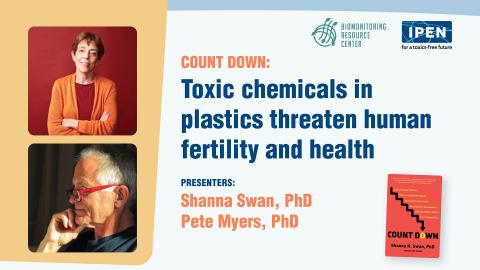Count Down: Toxic chemicals in plastics threaten human fertility and health
Chemicals in plastics have a variety of health consequences, and none more startling than the potential impacts on human fertility. In the same way that plastic additives and fire-retardant chemicals can disrupt endocrine function in kidneys or the pancreas — even at very low doses — they can have effects on ovaries and testes and the entire reproductive system. Studies show that fertiility has decreased over the past few decades, and work by researchers has linked some of these declines with the effects of ubiquitous toxic chemicals that have gone unregulated or that have persisted in the environment.
In July 2021, IPEN and Commonweal's Biomonitoring Resource Center hosted a webinar with two leaders in this research, Dr. Shanna Swan, from the Icahn School of Medicine at Mount Sinai in New York City, and Dr. Pete Myers, Founder and Chief Scientist at Environmental Health Sciences. Dr. Swan's recent book "Count Down: How Our Modern World Is Threatening Sperm Counts, Altering Male and Female Reproductive Development, and Imperiling the Future of the Human Race" delves into the causes and issues surrounding this disturbing trend. In the webinar, she reviewed the findings from her book and outlined the issues we face in dealing with harms to human health. In his presentation, Dr. Myers detailed many of the issues faced in terms of threats to fertility, but also to other human and wildlife disease, such as the faulty regulatory thresholds currently in use by governments, which fail to account for non-monotonic effects at very low doses often seen with endocrine-disrupting chemicals (EDCs), the specific mechanisms of chemicals within cells, and the trans-generational impacts rarely discussed in popular media, brought about by epigenetic effects of chemicals and their metabolic by-products.
A recording of the webinar is now available in English and español (Spanish).

